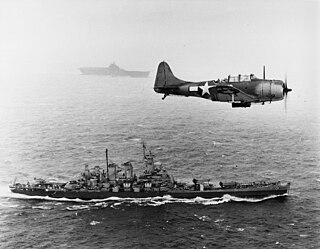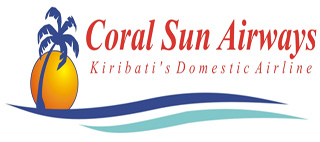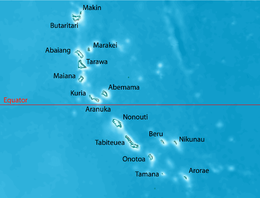
Kiribati, officially the Republic of Kiribati, is an independent island nation in the central Pacific Ocean. The permanent population is over 119,000 (2020), more than half of whom live on Tarawa atoll. The state comprises 32 atolls and one raised coral island, Banaba. They have a total land area of 811 square kilometres and are dispersed over 3.5 million km2 (1.4 million sq mi).

The islands which now form the Republic of Kiribati have been inhabited for at least seven hundred years, and possibly much longer. The initial Austronesian peoples’ population, which remains the overwhelming majority today, was visited by Polynesian and Melanesian invaders before the first European sailors visited the islands in the 17th century. For much of the subsequent period, the main island chain, the Gilbert Islands, was ruled as part of the British Empire. The country gained its independence in 1979 and has since been known as Kiribati.

Kiribati is a full member of the Commonwealth, the IMF and the World Bank, and became a full member of the United Nations in 1999. Kiribati hosted the Thirty-First Pacific Islands Forum in October 2000. Kiribati has Least Developed Country Status and its interests rarely extend beyond the region. Through accession to the Lomé Convention, then Cotonou Agreement, Kiribati is also a member of the African Caribbean and Pacific Group. Kiribati maintains good relations with most countries and has particularly close ties to Pacific neighbours Japan, Australia, and New Zealand. Kiribati briefly suspended its relations with France in 1995 over that country's decision to renew nuclear testing in the South Pacific.

The Gilbert Islands are a chain of sixteen atolls and coral islands in the Pacific Ocean, about halfway between Papua New Guinea and Hawaii. From 1976 to 1979, they were the “British colony of the Gilbert Islands”, and before that, from 1916 to 1975, they were the “Gilbert and Ellice Islands colony”. They constitute the main part of the nation of Kiribati (the name of which is a rendering of “Gilberts” in the phonology of the indigenous Gilbertese.

The Gilbert and Ellice Islands in the Pacific Ocean were part of the British Empire from 1892 to 1976. They were a protectorate from 1892 to 12 January 1916, and then a colony until 1 January 1976. The history of the colony was mainly characterized by phosphate mining on Ocean Island. In October 1975, these islands were divided by force of law into two separate colonies, and they became independent nations shortly thereafter: The Ellice Islands became Tuvalu in 1978, and the Gilbert Islands became part of Kiribati in 1979.

Butaritari is an atoll in the Pacific Ocean island nation of Kiribati. The atoll is roughly four-sided. The south and southeast portion of the atoll comprises a nearly continuous islet. The atoll reef is continuous but almost without islets along the north side. Bikati and Bikatieta islets occupy a corner of the reef at the extreme northwest tip of the atoll. Small islets are found on reef sections between channels on the west side. The lagoon of Butaritari is deep and can accommodate large ships, though the entrance passages are relatively narrow. It is the most fertile of the Gilbert Islands, with relatively good soils and high rainfall. Butaritari atoll has a land area of 13.49 km2 (5.21 sq mi) and a population of 3,224 as of 2015. During World War II, Butaritari was known by United States Armed Forces as Makin Atoll, and was the site of the Battle of Makin. Locally, Makin is the name of a separate but closest atoll, 3 kilometres to the northeast of Butaritari, but enough close to be seen. These two atolls share the dialect of Gilbertese language.
Gilbertese or taetae ni Kiribati, also Kiribati, is an Austronesian language spoken mainly in Kiribati. It belongs to the Micronesian branch of the Oceanic languages.
Makin Island may refer to:

The Gilbert and Marshall Islands campaign were a series of battles fought from November 1943 through February 1944, in the Pacific theatre of World War II between the United States and Japan. They were the first steps of the drive across the central Pacific by the United States Pacific Fleet and Marine Corps. The purpose was to establish airfields and naval bases that would allow air and naval support for upcoming operations across the Central Pacific. Operation Galvanic and Operation Kourbash were the code names for the Gilberts campaign that included the seizures of Tarawa and Makin, during the Battle of Tarawa of 20-23 November and the Battle of Makin of 20–24 November 1943. Operation Flintlock and Operation Catchpole were aimed at capturing Japanese bases at Kwajalein, Eniwetok, and Majuro in the Marshall Islands.

Dance in Kiribati includes various styles unique to the island nation. The uniqueness of Kiribati dance when compared with other forms of Pacific Islands dance is its emphasis on the outstretched arms of the dancer and the sudden birdlike movement of the head. The Frigate bird on the Kiribati flag refers to this bird-like style of Kiribati dancing. Most dances are in the standing or sitting position with movement limited and staggered.
The Kiribati National Championship is the top division of competitive football in the nation of Kiribati, founded in 2002 by the Kiribati Islands Football Association (KIFA), the nations football governing body. The association and the National Championships are based in the capital city, South Tarawa.

Makin is the name of an atoll, chain of islands, located in the Pacific Ocean island nation of Kiribati. Makin is the northernmost of the Gilbert Islands, with a population of 1,990.
Butaritari Airport is an airport on Butaritari in the Pacific Ocean island nation of Kiribati.

The Cabinet of Kiribati is the cabinet of the government of the Republic of Kiribati.

Coral Sun Airways is the younger of two Kiribati airlines, established in January 2009. The airline operated domestic service to all 17 airports in the Gilbert Islands, but stopped any regular service and offers only on-demand and chartered flights. In 2015 it purchased one new, larger aircraft, capable of flying to the Phoenix Islands and Line Islands. There was no domestic nor international service to these remote archipelagos to the east of the Gilbert Islands, having 8,800 and 20 inhabitants, respectively, except for one weekly flight on Fiji Airways between Honolulu and Kiritimati (Christmas) Island among the Line Islands, and Air Kiribati domestic flights between the Line Islands.

Air Tungaru was the first airline of Kiribati. As the predecessor of current Air Kiribati, it was Kiribati's national flag carrier. Air Tungaru's main base was the international airport at Kiribati's capital, South Tarawa. From there, regular service was provided to all 16 domestic airports in the Gilbert Islands.
Japanese presence in Kiribati dates back to the end of 19th and 20th century when labourers were hired to work in Kiribati's phosphate mines, but some workers and labourers came from Okinawa as soon as 1860. As compared to the other Micronesian countries which came under Japanese rule in the first half of the 20th century, the majority of the Japanese consisted of transient workers and only a few settled in Kiribati. Since Kiribati became independent in 1978, a few Japanese have also taken permanent residence in Kiribati, and assumed important positions within Gilbertese society.
Martin Miriata is an I-Kiribati footballer who plays as a Striker for current champions Makin football club. In the Kiribati Islands Football Association (KIFA). He represents Kiribati at international level.

The Japanese occupation of the Gilbert Islands was the period in the history of Kiribati between 1941 and 1945 when Imperial Japanese forces occupied the Gilbert Islands during World War II, in the Pacific War theatre.












